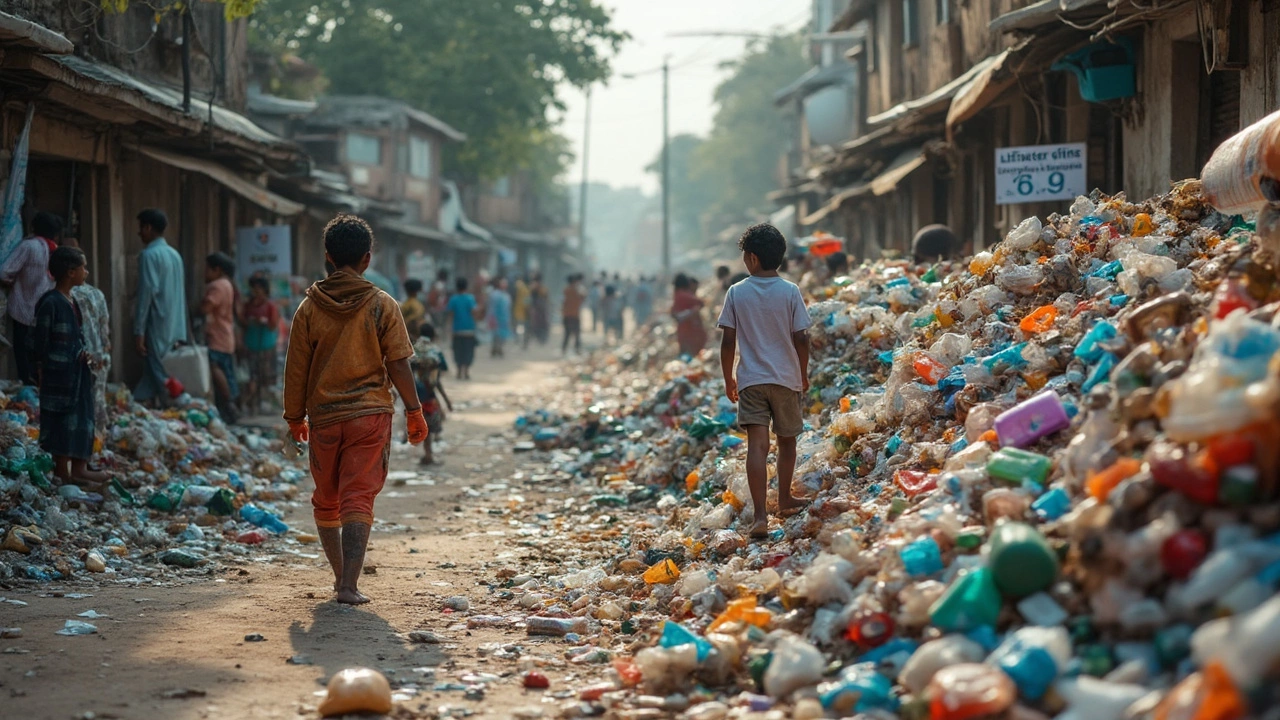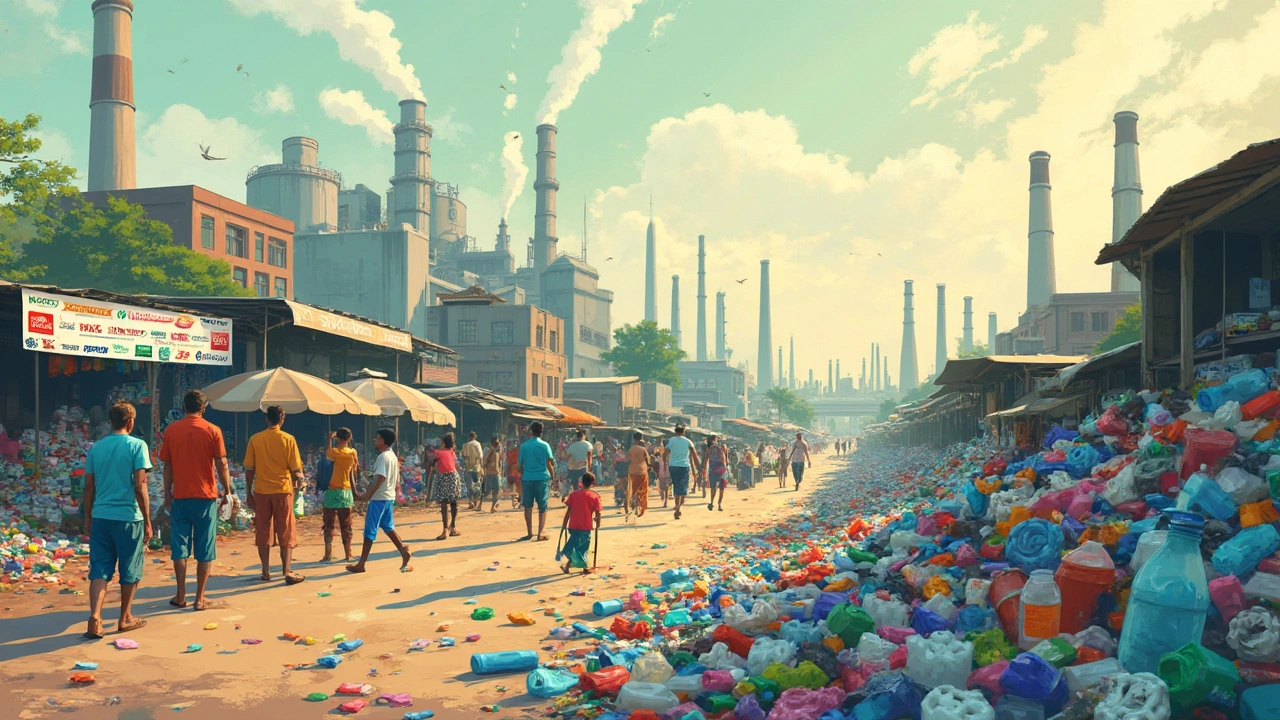Ever grabbed a drink, unwrapped a snack, or picked up groceries and wondered who actually made all that plastic? It’s not just a few random factories—it's the same massive companies behind the most recognizable brands. The real surprise? Just a handful of plastic manufacturers pump out almost all the wrappers, bottles, bags, and packaging scattered across the globe.
When people talk about the plastic problem, they usually picture consumers throwing stuff away. But at the very top, the problem starts with the companies making the plastic in the first place. By understanding who's responsible, you can make smarter choices when you shop, and maybe even apply some pressure right where it counts.
- The Main Players in Plastic Production
- How Much Plastic Do These Companies Make?
- Plastic, Packaging, and Everyday Life
- Tips to Avoid Products from Top Plastic Polluters
The Main Players in Plastic Production
Let’s get straight to it—less than 20 big companies are behind more than half of the world’s plastic waste. These aren’t just any companies; these are powerhouses you’ll see at the top of nearly every global plastics report. Topping the list is ExxonMobil, the largest single-use plastic producer out there. They crank out millions of tons of plastic every year, most of which ends up in single-use stuff like bags and packaging. Right behind them is Dow, another U.S.-based giant. The numbers don’t lie: Between them, they’re shaping how plastic ends up in nearly every corner of our lives.
The parade doesn’t stop in the U.S. China’s Sinopec and Saudi Aramco are both huge, pushing out tons of raw plastic materials that wind up in every country you can imagine. India’s Reliance Industries is right in the mix too—these guys make so much plastic that it’s tough to find a soda bottle in South Asia without their footprint on it.
Here’s a quick lowdown of the biggest names shaping the plastic manufacturing scene:
- ExxonMobil (USA)
- Dow (USA)
- Sinopec (China)
- Saudi Aramco (Saudi Arabia)
- Reliance Industries (India)
These companies supply the resin pellets and chemicals that get turned into the grocery bags, food containers, and bottles you see everywhere. They usually sell to other manufacturers who shape the plastic into products and packaging for well-known brands. So, most of the time, the label you see on the shelf isn’t the original source of the plastic—it all traces back to these top plastic production companies.
If you’re wondering about power, these companies also have a lot of pull with governments and trade organizations. They lobby for weaker plastic regulations and slow down bans or taxes that could cut demand. That’s why, even if consumer demand starts shifting, it can take a while to see a big change in how much plastic fills the planet.
How Much Plastic Do These Companies Make?
Here's where things get wild: the volume of plastic certain companies pump out is almost hard to believe. According to a Break Free From Plastic audit, just twenty companies are behind more than half of the world’s single-use plastic waste. Most folks have heard of ExxonMobil, Dow, and Sinopec. These giants top the charts, each producing millions of tons of plastic every year. In 2023, ExxonMobil was the world’s number one—producing nearly 6 million metric tons of single-use plastic. That’s enough to wrap the planet in plastic wrap multiple times.
Dow, based in the US, is not far behind, cranking out close to 5.6 million metric tons of single-use plastic in a year. Sinopec, a huge China-based company, is right there with them, producing over 5 million metric tons. Put another way, these guys are responsible for more plastic packaging than all the small plastic producers around the world combined.
It’s not just the raw numbers that blow your mind—it’s the speed. Every year, humans create over 400 million metric tons of plastic, and the biggest companies are the ones driving those numbers up. Many smaller firms supply local markets, but the plastic production heavyweights supply the world’s biggest brands. Their products become bottles for sodas, packets for chips, containers for shampoo, and pretty much anything you find in a supermarket shelf.
To make it even clearer, here’s a quick list of the top producers, based on single-use plastic output in recent years:
- ExxonMobil – nearly 6 million metric tons
- Dow – about 5.6 million metric tons
- Sinopec – slightly over 5 million metric tons
- Indorama Ventures (Thailand) – almost 4 million metric tons
- Saudi Aramco – well over 3 million metric tons
What does this mean for everyday life? Almost every piece of throwaway plastic you see started at one of these companies’ plants. Understanding these numbers puts the scale of the problem into perspective. It also hints at where pressure and change need to start—right at the supply level.

Plastic, Packaging, and Everyday Life
If you check your fridge or pantry, almost everything—from frozen veggies to ketchup—comes wrapped or bottled in plastic. Here’s the thing: over half of all plastic made is for packaging. That means it’s usually used once, then tossed.
Supermarket chains fill their shelves with items sold in plastic bags, trays, and wraps, mainly because it's cheap, lightweight, and keeps things fresh. Soft drink and water bottles are one of the biggest sources of plastic waste, and the same goes for snack food wrappers. Even those little single-use condiment packets add up fast.
A lot of this plastic comes from just a handful of huge companies. For example, Coca-Cola, PepsiCo, and Nestlé have been the world’s top branded plastic polluters several years in a row, mostly because of all the plastic bottles and wrappers they produce. But they often buy their material from bigger suppliers like ExxonMobil, Dow, SABIC, and Sinopec. These plastic producers sell raw materials that end up everywhere—from your morning yogurt cup to the cap on your toothpaste tube.
Here’s a quick snapshot of what everyday plastic looks like in numbers:
| Type of Plastic | Common Packaging Uses | Average Time Used Before Disposal |
|---|---|---|
| Polyethylene Terephthalate (PET) | Water & soda bottles, food jars | Less than 1 week |
| High-Density Polyethylene (HDPE) | Milk jugs, detergent bottles | 1-3 weeks |
| Low-Density Polyethylene (LDPE) | Plastic bags, bread bags | Less than 1 day |
| Polypropylene (PP) | Caps, yogurt containers | 1-2 weeks |
What’s wild is that almost 91% of plastic isn’t recycled. Most packaging is used for less than a month, but it sticks around in landfills and oceans for hundreds of years.
So, next time you see a plastic wrapper, it’s not random—it likely comes from the world’s plastic production leaders and ends up as waste almost right after you use it. Being aware of these habits can help you swap single-use for reusable stuff, cut down on waste, and make a bigger impact than you might think.
Tips to Avoid Products from Top Plastic Polluters
Trying to sidestep products from the world’s biggest plastic makers? The tough part is recognizing their reach, because these companies supply plastic to pretty much every major brand. Companies like ExxonMobil, Dow, Sinopec, and Indorama Ventures aren't just making bottles or bags themselves—they’re selling the raw material to the folks actually putting your snacks, drinks, and takeout in plastic. According to a 2023 report by Break Free From Plastic, just 20 companies are responsible for over 55% of global single-use plastic waste.
Here’s what makes a real difference when trying to cut out stuff from top plastic production giants:
- Read packaging labels: Companies rarely put their plastic supplier on the product, but look for recycling codes. Number 1 (PET) and Number 4 (LDPE) are most common from the big polluters.
- Buy in bulk or refill: The less packaging, the less plastic you support. Hit bulk stores and bring your own containers when you can.
- Pick glass, metal, or carton options: A lot of brands now offer glass bottles or cardboard cartons for stuff like milk, sauces, and drinks—these are less likely to come from the big petrochemical players.
- Support "plastic-free" brands: There are brands actively working to ditch plastic, especially for shampoo bars, cleaning tablets, and reusable packaging. Check if the brand is certified by credible groups like Plastic Free Foundation.
- Skip the top offenders: If a product’s whole look is plastic-heavy (think individually wrapped snacks or water bottles), chances are high it started with a top industry player.
Here’s a quick snapshot of who makes the most single-use plastic waste, according to the 2023 Minderoo Foundation report:
| Company | Share of Global Single-Use Plastic Waste | Main Product Types |
|---|---|---|
| ExxonMobil | 5.9% | Plastic packaging, bottles, bags |
| Dow | 5.6% | Wrappers, films, containers |
| Sinopec | 5.3% | Food packaging, industrial plastics |
| Indorama Ventures | 4.6% | Bottles, beverage containers |
The next time you’re shopping, just slow down for a second, check the packaging, and ask yourself if you really need that product wrapped in plastic. Simple changes add up, and companies do pay attention when demand starts to shift—so your choices make more impact than you think.

